Kenneth L. Gentry Jr.'s Blog, page 20
December 22, 2023
THE ISAIAH 9 CHILD
PMW 2024-099 by Kenneth L. Gentry, Jr.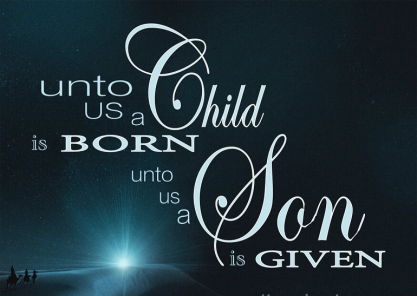
In Isa. 9:1–7 we find a glorious climax to all the preceding prophetic material. Judah’s ultimate hope (vv. 1–2) is in the Messiah who will righteously rule (vv. 6–7) over a free and prosperous people (vv. 3–4). These words should spur the Jews to faithfulness during their time of fearful oppression (8:7–8). Had they acted in faith, God would have sent the Messiah much earlier, since God presents her with conditional promises (e.g., Lev. 26).
Isa. 9:1–2: He treated the land of Zebulun … with contempt
The northern parts of the land, which were the most distant from Jerusalem and the closest to the enemy, suffered the most (2 Kgs. 15:29). Yet they will one day be made glorious (v. 1). Their darkness will be turned to light (v. 2). Again, Judah’s judgment will not cause total destruction. This finally comes to pass in the New Testament when Jesus comes into the area (Matt. 4:13–16), which begins the dawn of a new day for the Gentiles.
Isa. 9:6a: a child will be born
The word “child” is the first word in the Hebrew, thereby receiving emphasis. Despite the mighty Assyrian king in all his glory (8:7) who will overwhelm the land (8:8), God’s ultimate deliverance will come through a child. The significance of “a son will be given” fundamentally means that he is the son of God. Isaiah includes himself among the happy recipients, for the son will be given to “us” (cp. 7:14).
New Testament Survey (47 mp3 lectures)
by Ken Gentry
Forty-seven formal Christ College course lectures in mp3 format.
Includes class interaction.
Lecture material demonstrates all four Gospels were written prior to AD 70.
See more study materials at: www.KennethGentry.com
Isa. 9:6b: the government will rest on His shoulders
Though Isaiah had previously lamented Israel’s rulers were but children, here he prophesies that the entire responsibility of government will rest on this child’s shoulders. To him will be given all power in heaven and on earth (Matt. 28:18; Luke 1:32–33; John 5:22). However, his kingdom is “not of this world,” so he does not govern by earthly norms (John 18:36–37). Rather, his is a spiritual kingdom (Mark 1:14–15; Luke 17:20–21).
Isa. 9:6c: His name will be called
As in Isaiah 7:14 the name of the child is stressed here. There it was “Immanuel,” meaning “God with us.” Here he is given four names, further stressing his glory — and his deity. For the four names granted to the coming son.
The name given first (for emphasis) is more concrete than in our translation, which treats it as an adjective. That name is “Wonder,” due to his deity (see Jdg. 13:17–18 Note). And he is a “Counsellor” to rule over his kingdom with wisdom (cf. Mic. 4:9).
Reformed Christmas (3 CDs)
Sermons by Ken Gentry
Expository sermons celebrating Christ’s birth in terms of his three-fold office (3 CDs).
See more study materials at: www.KennethGentry.com
The second name given is “Mighty God.” This harkens back to Psalm 2:7: “You are my Son, / Today I have begotten You.” Thus, he is “the only begotten Son” (John 3:16), so that in Jesus God “has spoken to us in His Son” (Heb. 1:2). In Isaiah el (“God”) is used only of God himself (e.g., 31:3). We see this clearly in the next few verses, where the remnant will return “to the mighty God” (10:21). That the Messiah is a “child” who is “born” (9:6a) underscores his humanity; that he is “Mighty God” expresses his deity. Thus, as recorded in Luke: “He will be great and will be called the Son of the Most High; and the Lord God will give Him the throne of His father David.”
His third name is “Eternal Father” emphasizes his everlasting love for his people as a father (Isa. 63:16; Psa. 103:13). But even more than this, it shows that he is eternal in his own being (Mic. 5:2) and is thus able to grant eternal life to his people.
The final name given this son is “Prince of Peace.” This name is appropriate in that he is to have the government rest on his shoulders In May 18, 2022fact, the war and oppression coming upon Israel expect the Messiah to do something about the problem by serving as a “prince” of peace, which will know no end (9:7).
Isa. 9:7a: There will be no end to the increase of His government
Messiah’s rule will not come full-blown all at once. Rather, when it comes it will incrementally increase throughout history on into eternity, being progressive and perpetual (Matt. 13:31–22; Mark 4:26–33; cp. 1 Cor. 15:20–28; see 11:6–8 Note). The increase will include the calling of the Gentiles (Gen. 12:3; Isa. 2:2–4; Zech. 9:6–7; Matt. 28:18–20; John 12:31–32; Rom. 4:13). Thus, the Jewish people will be expanded to include Gentiles thereby become the new covenant (Christian) church (Isa. 19:20–25; Gal. 3:29; Eph. 2:12–16). The effective cause of this glorious kingdom is that God’s “zeal” will “accomplish this.”
Isa. 9:7b: On the throne of David
David was a type of Christ, foreshadowing him centuries in advance of his incarnation (for the meaning of a “type.” David’s throne was to be “eternal,” which speaks of Christ’s kingdom rule (2 Sam. 7:12–14; Luke 1:21–32).
December 19, 2023
THE VIRGIN BIRTH
PMW 2023-098 by Kenneth L. Gentry, Jr.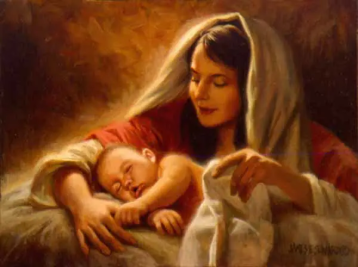
The most crucial aspect of the debate over the prophecy in Isaiah 7:14 is the meaning of the Hebrew word alma. It is translated “virgin” in most English versions (ASV, ESV, ISV, NASB, NIV, NKJV), though most of those have a marginal note offering the option “maiden” or “young woman.” A few versions do not have “virgin” as the main translation (NAB, NET, NRSV, RSV).
“Therefore the Lord Himself will give you a sign: Behold, a virgin will be with child and bear a son, and she will call His name Immanuel. (Isa. 7:14)”
The word alma is based on a root which means “to be strong,” i.e., one who is approaching full maturity, therefore the time of marriage. The word does mean “young woman, maiden,” and is often used that way in the Old Testament. But in some cases it definitely speaks of an unmarried young woman who is a virgin (Gen. 24:43; Exo. 2:8; and probably Song 6:8). There is no example in the Old Testament of it referring to a married woman. So, it is possible that it means “virgin” here in Isaiah.
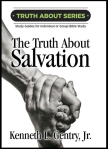 The Truth about Salvation By Ken Gentry
The Truth about Salvation By Ken Gentry
A study guide for personal or small group Bible study. Deals with the Christian doctrine of salvation from a Reformed theological perspective. It opens with a study of God as loving Creator, the shows how the first man fell into sin. Shows God’s righteousness requires that sin be dealt with. Presents Jesus as both God and man so that he can be man’s Savior. Includes review questions and questions for further study.Twelve chapters are ideal for one quarter of Sunday School.
See more study materials at: www.KennethGentry.com
Several lines of evidence strongly support the meaning “virgin” here, showing that it does not simply refer to a young woman having a baby: (1) God commanded Ahaz to seek a remarkable sign (“as deep as Sheol or high as heaven,” v. 11). A young woman having a baby is not remarkable. (2) It was to serve as a “sign” during a time of national fear (vv. 1–2), at which time a young pregnant woman would not be a sign. (3) The word “behold” anticipates something dramatic.
(4) Critical scholars argue that this prophecy probably refers to the wife of Isaiah or of Ahaz, or possibly Hezekiah’s mother. But the child’s name “Immanuel” is a unique name never applied to anyone else in the Old Testament — not even to the child in each of these three suggestions. It is applied to Jesus when he was born, however (Isa. 1:23). It has a significant meaning expressing God’s special presence (“God is with us”). Immanuel is addressed in a remarkable way in the next chapter, suggesting this is not a normal person. There when speaking to Immanuel, the land of Israel is called “your land” (8:8). And just after that, the meaning of this name is used to promise that no plan can be devised against the land (8:10).
(5) Two chapters later in this same series of prophecies, the Messiah is once again presented (9:6). There he is called “Wonderful,” “Mighty God,” and “Eternal Father,” which names well describe the divine Messiah but no normal earthly child of a young maiden. The second prophecy makes progress over the first: in 7:14 the son is to be born, whereas in 9:6 he is presented as actually born. Interestingly, neither 7:14 nor 9:6 (nor Micah 5:3) mention a father when speaking of the Messiah’s coming (cp. that same tendency in Luke 3:23).
Lord of the Saved
(by Ken Gentry)
A critique of easy believism and affirmation of Lordship salvation. Shows the necessity of true, repentant faith to salvation.
See more study materials at: www.KennethGentry.com
(6) The Septuagint (Isa. 7:14) and the New Testament (Matt. 1:21) both translate this word by the Greek word parthenos, which always means a “virgin.” We cannot explain why the Septuagint translators chose this word if they did not understand the prophecy to speak of a virgin.
December 15, 2023
THE BLACK WOMAN IN SOLOMON’S SONG
PMW 2023-098 by Kenneth L. Gentry, Jr.
In today’s posting I will focus on the opening verses of the Song of Solomon. The text regarding Solomon’s black bride-to-be is usually misinterpreted — along with the rest of the book.
Song is perhaps the most difficult book in the Old Testament to interpret, rivaling even Revelation in the New Testament. Interpretations include its being an allegory (either of God’s love for Israel or for Christ and the Church), a drama (an actual romantic play), a cultic celebration (i.e., speaking of a fertility cult), a funeral cult ritual (cf. 8:6), an actual wedding ceremony text, or a love song (either of an historical event or a purely poetic exercise). Yet, sufficient evidence suggests that it is a love poem celebrating the sexual relationship between a bride-to-be and her husband-to-be. It is not a love story presented as a formal drama, per some interpreters (e.g., the famed Franz Delitzsch), for it offers little character development and virtually no plot line.
The poem’s imagery speaks directly to its message regarding true love. The images do not stand for various theological truths, political issues, or philosophical matters. Rather, the work is a lyrical love poem presented largely through dramatic dialogue exchanged between a young man (cf. Song 2:3, 9, 17; 8:14) and a maiden who is beautiful both physically (1:8–11, 15; 2:10, 14, 13; 5:9; 6:1; 7:1–6) and morally (6:3, 9; 7:10; see 3:1–5 Ext. Note; 8:10 Note).
It basically functions as a poetically-framed parable celebrating the purity, dignity, depth, and joy of true, romantic, sensual love. It pictures the devoted, rapturous love of a young man for a maiden. Despite some interpretations, it does not include a third party (usually seen as Solomon), who attempts to separate a country girl from her true love in order to bed her down. It is a beautiful, warm, moving, and emotional love song, not a story of a lustful attempt at seduction and manipulation.
Although not certain, it probably is based on a temporary experience from Solomon’s early adult life. If so, it would picture the true, monogamous love he shared in his first marriage to a Shulamite bride (6:13) while he was a young king. If not based on his own experience, however, it could be his poetically idealized presentation of true love.
Openness Unhindered (by Rosaria Butterfield)
Dr. Butterfield goes to great lengths to clarify some of today’s key controversies. She also traces their history and defines the terms that have become second nature today-even going back to God’s original design for marriage and sexuality as found in the Bible. She cuts to the heart of the problems and points the way to the solution.
See more study materials at: www.KennethGentry.com
Let’s consider the first few verses to get us off on the right track.
Song 1:2–4a
This stanza opens the poem and announces its romantic theme. The text does not indicate who is speaking, but it is obviously not the male lover. Rather, it is his true love, a young woman, his bride-to-be. She will be the dominant speaker throughout the poem, for regarding those verses which we can determine with certainty who is speaking, she speaks in fifty-six of them, compared to the man’s thirty-six.
Song 1:2
May he kiss me with the kisses of his mouth
The poem opens with this fundamental act of affection: an intimate kiss on the lips (not a peck on the cheek). By stating that the man’s love is better than wine, the young woman is declaring that it is both enjoyable (Psa. 104:15; Eccl. 10:19; Zech. 10:7) and intoxicating (Gen. 9:21; 1 Sam. 1:14; Eph. 5:18). These first words set the tone for the whole romantic story. Later these words will be returned to her by her lover (4:10).
Song 1:4a
The king has brought me into his chambers
The bride-to-be is excited and desires to run away with her lover (“let us run together,” v. 4a), a theme that will frequently arise (cp. 2:10, 13; 4:8; 7:11, 12). She then exhorts him to take her into his bed chamber, i.e., the wedding chamber (v. 4b). This verb is a cohortative (an exhortation) rather than a past tense, and reads better as: “Let the king bring me into his chambers” (NIV). She wants to be married now.
Song 1:4b
We will rejoice in you
Though the chorus is not properly introduced, the plural references (“we will rejoice” / “we will extol”) clearly shift from the singular (“kiss me” / “draw me, vv. 2, 4). The chorus is composed of the “daughters of Jerusalem,” to which the bride-to-be will soon speak (v. 5). They rejoice in and praise her love for the king. Earlier the girl praised her lover the king by noting “the maidens love you” (v. 3c); now the chorus of maidens commends him by declaring that this is right: “rightly do they love you.”

Covenantal Theonomy
(by Ken Gentry)
A defense of theonomic ethics against a leading Reformed critic. Engages many of the leading objections to theonomy.
See more study materials at: www.KennethGentry.com
Song 1:5–6
I am black but lovely
Solomon’s lover declares she is “black” (v. 5) or better, “dark.” This has nothing to do with her race; she is a Jew (from the tribe of Issachar, see 6:13), not an Ethiopian. This statement betrays her social status as a field-laborer. Her statement that “I am dark but” is defensive, suggesting social prejudice against her peasant status (see v. 6a). This is despite her love for “the king” (v. 4), who would normally seek out a beautiful woman (e.g., 1 Kgs. 1:3–4; Est. 2:2–3). The “but” shows that although she is darkened by laboring in the sun, she is nevertheless, “lovely,” i.e., beautiful in bodily shape and facial features. Thus, this is a defensive statement regarding her field appearance.
The word shachor, which is translated “black,” should be rendered “dark” (v. 5; see NIV, ESV) for several reasons: (1) The actual word covers a range of shades from dark to raven black (cp. 5:11). Thus, “dark” is a lexical option. (2) She declares that her dark skin is like the heavy “tents of Kedar,” which were made of gray or black goat hair in which bedouin shepherds lived (Isa. 60:7; Jer. 49:28–29; Eze. 27:21). (3) The root of the word “dark” is qadar, which means “to be dark, darken, grow dark,” like dark rain clouds (Jer. 4:28) or the moon in a shadowed eclipse (Joel 2:10).
(4) She claims she is “swarthy,” shecharchoreth (v. 6a). This is the diminutive of “black” (shachor), suggesting she is not fully black, but less black, blackish, i.e., dark. (5) Contextually, her skin is dark because “the sun has burned me” (v. 6b), i.e., tanned. Thus, her darkness is not natural the Ethiopian (Jer. 13:23). (5) She has been forced to take care of her brothers’s several vineyards (v. 1:6d; see 1:6 Note), which would require much time outside in the sun (cf. Lev. 25:3; Jdg. 9:27; Matt. 21:1, 28). She did not even have time to take care of her own vineyard (1:6e).
That she says “I am dark but lovely” suggests social prejudice from the upper class. This upper class could well be reflected in “the daughters of Jerusalem.” They dwell in a finer urban setting in the confines of the capital city rather than laboring out in the fields with the field hands. Notice her plea for them not to stare at her (v. 6a) and their later criticism of her beloved (5:9).
Yet she is nevertheless “lovely” in appearance. Though her skin may be like dark bedouin tents, her overall loveliness is like the “curtains [Heb., yeriah] of Solomon.” This probably refers to the beautiful curtains [yeriah]of the tabernacle (Exo. 26:1–13; 36:8–17) that would have been replicated in Solomon’s temple.
This is introducing a love song; not a typology of Christ and his church.
December 12, 2023
INTRODUCING ISAIAH (3)
 PMW 2023-097 by Kenneth L. Gentry, Jr.
PMW 2023-097 by Kenneth L. Gentry, Jr.
This is my final article on the introduction to Isaiah. Please see previous two posating before reading this one.
SPECIAL ISSUES
One of the most hotly-debated issues in biblical studies concerns the authorship of Isaiah: was it written by one author or by several over a 100+ year period, only eventually being compiled as one book. Before the rise of modern biblical criticism, the unity of Isaiah was the historic position of Judaism and Christianity. Before the eighteenth century, only the twelfth century Jewish commentator Ibn Ezra (1089–1167 AD) questioned the book’s unity.
The beginning of modern criticism. In 1780 the French Old Testament scholar Jean Astruc began the modern critical movement in biblical studies. He started Pentateuchal criticism, arguing that Moses did not write Genesis but that it is an edited compilation derived largely from two main sources. This movement quickly began critical analysis of other books of Scripture challenging the longstanding, historic understanding of biblical authorship.
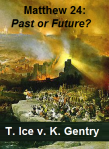 Great Tribulation: Past or Future?
Great Tribulation: Past or Future?
(Thomas Ice v. Ken Gentry)
Debate book on the nature and timing of the great tribulation. Both sides thoroughly cover the evidence they deem necessary, then interact with each other.
See more study materials at: www.KennethGentry.com
By 1892 German biblical scholar Bernhard Duhm (1847–1928) was arguing that Isaiah was a compilation of prophecies from three authors: the actual prophet Isaiah wrote chapters 1–39, now called Proto-Isaiah by critics, in the eighth century BC. But some unknown prophet wrote Deutero-Isaiah, chapters 40–55, in the mid-sixth century BC. Then another unknown prophet, wrote Trito-Isaiah, chapters 56–66 sometime after the return from exile.
The argument for multiple authorship. Five of the leading critical arguments are:
First, Isaiah 44:28 and 45:1 expressly name the sixth-century Persian ruler Cyrus (559–530 BC). This is over 150 years before he comes on the historical scene, which detailed prophecy is deemed impossible by anti-supernaturalists.
Second, Isaiah 40–66 reads as if Jerusalem had already fallen and the Babylonian exile had already begun rather than its being predicted in advance. For instance, Isaiah 42:22: “But this is a people plundered and despoiled; / All of them are trapped in caves, / Or are hidden away in prisons; / They have become a prey with none to deliver them, / And a spoil, with none to say, ‘Give them back!’” And Isaiah 51:17: “Rouse yourself! Rouse yourself! Arise, O Jerusalem, / You who have drunk from the Lord’s hand the cup of His anger; / The chalice of reeling you have drained to the dregs.”
Have We Missed the Second Coming: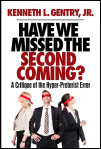
A Critique of the Hyper-preterist Error
by Ken Gentry
This book offers a brief introduction, summary, and critique of Hyper-preterism. Don’t let your church and Christian friends be blindfolded to this new error. To be forewarned is to be forearmed.
For more Christian educational materials: www.KennethGentry.com
Third, Isaiah 40–66 presents new ideas and words, moving in a different world of discourse from the earlier chapters. For instance, Second Isaiah’s audience is non-political, hearing no mention of involvement in foreign affairs or trust in men and horses. Fourth, these latter chapters are more impassioned and lyrical than the earlier chapters. Cities and nature are often personified and presented more dramatically. Fifth, the earlier section of Isaiah focused more on God’s majesty, whereas the latter chapters highlight his uniqueness as the only God.
A defense of unified authorship. Over against the critical arguments we may note: First, all ancient traditions recognized the antiquity and unity of Isaiah. Around 400 BC, 2 Chronicles 32:32 speaks of the book of Isaiah as existing at that time, without any assumption of its composite nature. In 200 BC the author of Ecclesiasticus (48:24–25) considered Isaiah as the author of the whole book. Around 150 BC the Qumran community already had several copies of the book, showing they accepted its integrity and from a much earlier period. And the first century A.D. New Testament clearly assumes one author for the whole of Isaiah. It cites from all sections of the book and attributes each to Isaiah. For example, see Isaiah 40:3 (Matt. 3:3); 53:4 (Matt. 8:17); 42:1 (Matt. 12:17); 6:9–10 (Matt. 13:14). It can even put verses from earlier and later sections of Isaiah in one passage, e.g., Isaiah 6:9–10 and 53:1 appear in John 12:38–39.
Second, there is no concrete evidence that any part of Isaiah existed separately from the rest, i.e., no Isaiah manuscripts separating the two or three sections, no discernible seams patching together the two or three parts, no ancient external statements from early writers. This should not be surprising in that the heading to the whole book states that it was written by Isaiah and covered four reigns (1:1) On the critic’s assumption, it is hard to explain how Isaiah came to exist as one book at all. Nor do we find in Isaiah any reference to another author, as we do in the case the Psalms (see headings of Psa. 42, 50, 72, 90) and Proverbs (e.g., Prov. 22:17; 25:1; 30:1-33; 31:1–9). We do, however, have sixteen internal references to “Isaiah,” with almost half of them specifying he is the “son of Amoz” (1:1; 2:1; 13:1; 20:2; 37:2, 21; 38:1).
Third, the critic’s position is subjective. Their methodology is rooted in an assumption rather than evidence. They hold as a rationalistic, anti-supernaturalistic postulate that predictive prophecy is impossible, spurring them to search for an alternative explanation.
For instance, their leading complaint is Isaiah’s prophesying the arising of king named “Cyrus” over 150 after Isaiah wrote (44:28; 45:1). But consider: (1) This effectively denies the existence of the self-revealing God of Scripture, which calls for a Christian apologetics response. Christian apologetics bases its truth claims on its worldview that explains all reality (including laws of logic, mathematics, morality, etc.) on the firm foundation of the self-contained, all-powerful, eternally-existent God of Scripture. Over against this worldview is the current secular worldview that is rooted in chance, establishing the rational world on the basis of ultimate irrationality. That is, it holds that a chance explosion from out of nothing produced material something, then this material something randomly gave rise to living something, then personality arose out of living things. And all of this serves as the foundation for the laws of science, mathematics, logic, and morality. The secular position is irrational through-and-through, and therefore subjective in the final analysis.
(2) Biblical prophets often based their challenges to Israel on their prophetic ability. Thus, any after-the-fact “prophecy” would be counter-productive, undermining their moral challenge to their hearers. This would make deceivers out of these great proponents of personal and social righteousness. (3) If we remove “Cyrus” from Isaiah’s prophecy in 44:26–28, it would wholly undercut his message. For God is emphasizing his ability to foretell future events by presenting Cyrus as an objective confirmation of his authority (cf. 41:26; 48:5; 42:8–9; 43:9, 12–13; 44:7–8).
Besides, (4) Isaiah does not engage in predictive prophecy only in Deutero-Isaiah (after ch. 39). For early in his book he names his son “Shear-jashub” (7:3), which means “a remnant shall return.” This is long before the Babylonian captivity, which is obviously before the return of the remnant from exile. Then in 39:5–7 he prophesies the destruction and exile of Judah by Babylon long before these occur. (5) In the chapters before Isaiah 40, we see a growing concern of the approaching exile (3:24–26; 5:5–6; 6:11–13; 24:11–12; 27:13; 32:13–18). Yet critics allow these as prophecies from Isaiah son of Amoz.
Fourth, the literary unity of Isaiah undermines multiple authorship over a long period. (1) We find verbal agreement between chapters 1–39 and chapter 40–66. Compare the following examples: 40:5 and 58:14 (cp. 1:20); 43:13 (cp. 14:27); 60:21 (cp. 29:23); etc. (2) Isaiah emphasizes holiness as a major unifying theme throughout his book (e.g., 1:4; 5:16; 8:14; 10:17; 17:17; 30:11; 37:23; 43:15; 45:11; 48:17). (3) There are major similarities between Isaianic sections: God is called “the Holy One” twelve times in Proto-Isaiah (1:4; 5:19; 10:17, 20; 12:6; etc.) and fourteen times in Deutero-Isaiah (40:25; 41:14, 16, 20; 43:3, 14, 15; 54:5; 60:9; etc.). This name for God is rare in the Old Testament, appearing only four times elsewhere (Psa. 71:22; 89:18; Jer. 50:29; 51:5). Forty-plus phrases first appearing in Proto-Isaiah appear later in Deutero and Trito-Isaiah: 14:27 (cp. 43:13); 28:5 (cp. 63:3); 34:8 (cp. 61:2); 35:10 (cp. 51:11); etc.
(4) Any slight differences between the sections can be easily explained by the fact that Isaiah wrote over a long period of time (cf. 1:1) and on diverse topics. The “higher” literary quality of Isaiah 40–66 could be expected as Isaiah develops his writing skills over time. After all, literary scholars can detect Shakespeare’s style changes in four periods of his works.
Fifth, though Deutero-Isaiah seems to presuppose that the exile is already in effect, this can be explained by the prophet adopting an ideal standpoint. That is, to make his prophecy more vivid, he is prophesying the future suffering of Israel by projecting himself and the people into that future. He even speaks thus in the early chapters that critics grant to Isaiah (e.g., 5:13; 6:11–13).
House Divided: The Break-up of Dispensational Theology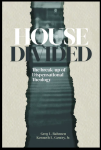 By Greg Bahnsen and Ken Gentry
By Greg Bahnsen and Ken Gentry
This book presents and defends Christian Reconstruction theology, particularly theonomic ethics and postmillennial eschatology. It does to by responding to dispensationalism’s social and exegetical theology.
For more educational materials: www. KennethGentry.com
Historical problems plague the critical view. First, Deutero-Isaiah refers to Jerusalem and other locales in Judah as if they are still in existence (40:9). This is despite their destruction by the Babylonians that had supposedly already occurred (cf. 2 Kgs. 25:9–10; 2 Chron. 36:19; Neh. 1:3; Jer. 39:8; 52:14). Trito-Isaiah even speaks of the walls of Jerusalem as if they are still intact (62:6; cp. 2 Kgs. 25:10).
Second, there are no social or geographical references providing evidence of Israel being in Babylon in exile. This is quite different from Ezekiel, who did live during Babylon’s conquest and shows evidence of such (Eze. 1:1; 19:9; 24:2). The writer of Isaiah 40–66 gives evidence of being in Israel. For instance, he mentions trees that are native to Israel (e.g., cedar, cypress, oak (41:19; 44:14)
Third, all references to Israel’s sin of idolatry in Deutero and Trito-Isaiah (40:19; 41:7, 29; 42:17; 44:9ff, 25; 45:15ff; 46:6ff; 63:3ff; 66:3, 17) are of the pre-exilic type (cf. 1:13, 29; 2:8ff; 8:19). We know, however, that after Jerusalem’s capture and destruction by the Babylonians, Israel never again engaged in idolatry — as we can see from the post-exilic writings of Haggai, Zechariah, and Malachi. For instance, Malachi has a list of Israel’s sins, but idolatry is not named (cf. Mal. 2:11, 13–16; 3:5, 7–12, 13–15).
The critical view of three Isaiah’s is unreasonable. All scholars recognize the high and exalted lyrical beauty of Isaiah 40–66. As previously noted, critical scholars even argue that the brilliant style of these chapters is evidence of their being written by an author different from and superior to Isaiah, who wrote chapters 1–39. But we should note that the book does not even hint at any other author(s), as is the case in Proverbs, which mentions Agur (Prov. 30:1) and Lemuel (31:1).
In addition, how could such an erudite and compelling writer have totally disappeared from history and tradition without a trace? No one in antiquity even mentions such a writer. And why would such an exalted work (chs. 40–66) be added as an appendix to a lesser Palestinian production (chs. 1–39)? If any other authors were involved, we must also wonder what led the editor(s) of Isaiah to be so definite about Isaiah’s identity as “the son of Amoz” (1:1)?
Click on the following images for more information on these studies:


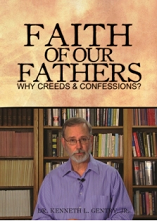
December 8, 2023
INTRODUCING ISAIAH (2)
PMW 2023-095 by Kenneth L. Gentry, Jr.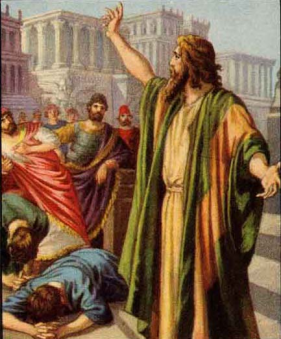
In this posting, I am continuing a brief historical and literary introduction to the Book of Isaiah. Such knowledge is helpful for better interpreting the text. We move now to consider:
PURPOSE
Isaiah ministered during a dangerous, tumultuous, and critical time. Judah and Israel have major world powers Egypt (Isa. 19), Assyria (Isa. 36), and Babylon (Isa. 13) either on the scene or looming in the near future. This problem is compounded by Israel’s unfaithfulness (e.g., 1:10–11; 6:9; 42:14–25; 43:22–28; 48:1–2). Therefore, some of Isaiah’s leading purposes include:
Isaiah calls Judah and Israel to repentance. Isaiah opens with a call to heaven and earth to serve as witnesses to God’s legal indictment against Judah and Israel (1:2–9). It was important for Isaiah to call the people to repentance by teaching salvation by grace (e.g., Isa. 1:18–20; 40:2; 43:1–7, 25; 44:28; 51:2; 55:1–13; 63:7–9).
Isaiah warns Judah and Israel not to depend upon men. Israel needed to depend upon God and not make alliances with pagan nations (14:28ff; 30:1ff; 31:1ff). Isaiah warns that pagan nations will be brought down by God, even mighty Assyria (10:5–19) and Babylon (Isa. 46–47).
Isaiah answers questions that arise due to Judah and Israel’s woes. Isaiah explains God’s sovereignty in allowing pagan nations to dominate faithless Judah and Israel (10:5–19; 46:1–47:15). He notes that Judah and Israel’s judgments come in various forms (24:4–5), including disease (1:5–8) and military defeat (5:26–30). Yet they are from God’s hand (43:27–28). He also speaks of the future of the Davidic monarchy (9:6–7; 22:22). He explains that God’s judgment does not imply God’ rejection of his people (10:20–22; 35:10; 41:9).
BEFORE JERUSALEM FELL
Doctoral dissertation defending a pre-AD 70 date for Revelation’s writing (459 pp; paperback). Thoroughly covers internal evidence from Revelation, external evidence from history, and objections to the early date by scholars.
For more study materials: https://www.kennethgentry.com/
Isaiah promises God’s mercy to Judah and Israel — as well as the nations of the world. The book of Isaiah emphasizes a time of universal peace and blessing both in its beginning (2:1–4) and its conclusion (65:17–25). Isaiah’s very name suggests a positive purpose in his prophecies, for “Isaiah” means “Yahweh is salvation.” And the same is true of the name Isaiah chooses for his first son, Shear-Jashub (7:3), which means “a remnant shall return.” Therefore, the prophet repeatedly emphasizes God’s forgiveness (1:18–19; 12:1; 30:18–19; 33:24; 38:17; 40:1–2; 59:20).
IMPORTANCE
Isaiah has been widely used. The book of Isaiah has long been important to God’s people. We see this in several ways. Among the Jews at Qumran, the second most cited book in the Dead Sea Scrolls is Isaiah, exceeded only by Deuteronomy. Not only do we find among these Scrolls a complete, well–preserved Isaiah scroll, but twenty partially-preserved copies. The New Testament alludes to Isaiah 411 times, directly quoting it over fifty times (e.g., Matt. 13:14–15; Luke 8:10; John 12:40; Acts 28:26–27; Rom. 9:29; Heb. 2:13; 1 Pet. 2:9).
The next three observations explain why Isaiah was so popular to New Testament writers.
Isaiah emphasizes important doctrines. Isaiah presents us with an exalted view of God. It especially emphasizes his sovereignty (6:1ff; 24:1–3; 37:15–20; 43:8–11) and his holiness (1:4; 5:16; 30:9–16; 37:23; 43:8–11). And in light of these glorious doctrines, it especially condemns human pride (2:11–18; 14:12–15; 37:23–25; 66:1–3).
Isaiah is strongly eschatological. With its strong emphasize on God’s sovereignty (see above), it repeatedly speaks of the future conversion of the Gentile nations (Isa. 2:2–4; 11:6–10; 19:16–25; 42:1–12; 49:5–6; 60:1–3).
Isaiah is strongly Messianic. Only Psalms has more references to Christ than does Isaiah. Of its many Messianic passages, we may include: 7:10–15; 9:1–7; 8:23–9:6; 11:1–16; 14:28–32; 24:21–23; 32:1–8; 33:17–24; 42:1–4; 49:1–6; 50:4–9; 52:13–53:12; 59:21; 61:1–3, 10–62:7; 63:1–6.

Dispensational Distortions
Three Lectures by Kenneth Gentry. Reformed introduction to classic dispensationalism, with analysis of leading flaws regarding the Church, kingdom, redemptive history, and Christ. Helpful for demonstrating errors to dispensationalists.
See more study materials at: www.KennethGentry.com
STRUCTURE
Isaiah is difficult to outline because of its great length, its non-chronological presentation, and its anthological nature (see above). Its non-chronological nature is clearly evident in that it waits for five chapters before it presents Isaiah’s call and commission (Isa. 6:1–9), which is foundational to his prophecies. We would generally expect to see this at the front of the book, as is the case with Jeremiah (Jer. 1:1–4) — though Amos gives his call later in his own prophecy (Amos 7:14–15).
Nevertheless, we may summarize its basic thematic structure in the following way:
I. GOD’S JUDGMENT (1–39)
A. God’s indictment of Judah (1–6)
B. Prophecies of deliverance (7–12)
C. Judgments on the Gentile nations (13–23)
D. Punishment and Blessing (24–27)
E. Woes and Warnings (28–33)
F. Punishment and Blessing (34–35)
G. Historical Interlude (36–39)
II. ISRAEL’S RESTORATION (40–66)
A. Comfort and Deliverance Promised (40–48)
B. Salvation from God’s Servant (49–57)
C. Salvation Completed (58–66)
Click on the following images for more information on these studies:


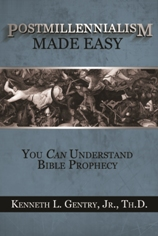
December 5, 2023
INTRODUCING ISAIAH (1)
PMW 2023-094 by Kenneth L. Gentry, Jr.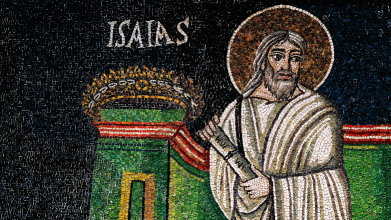
Isaiah is one of the best-known, best-loved and most studied OT prophets. When opening a book of the Bible, it is always helpful to have at least a general understanding of several key issues. The Bible is an historical book dealing with real history. The more we know about its setting and issues, the better we can understand it. In this brief series I will introduce Isaiah.
TITLE
Technically, the title of this book is “The Vision of Isaiah,” as derived from its opening verse. This is actually confirmed by 2 Chronicles 32:32. That it is titled a “vision” is uncommon among the prophets, with Obadiah being the only other one using this word in his very opening (“the vision of Obadiah,” Oba. 1:1). Generally the prophets open with “the word(s) of” (e.g., Jer. 1:1; Eze. 1:3; Hos. 1:1; Joel 1:1; Amos 1:1).
As per virtually all prophetic books (except for Daniel), the prophet’s name appears in its opening verse (1:1; though Ezekiel’s name is delayed until his second verse). Isaiah is named for its author, whose Hebrew name as spelled in this title (v. 1a) is yesha’yah. This is how this name appears for other persons (1 Chron. 3:21; Ezra 8:17, 19; Neh. 11:7). In the New Testament Greek “Isaiah” is rendered Esaias and in the Latin Vulgate, Isaias. In the actual text of this prophetic book, however, it appears sixteen times and always in its longer form: yesha’yahu. Yet, the name by either spelling means “Yahweh is salvation.”

Greatness of the Great Commission (by Ken Gentry)
An insightful analysis of the full implications of the great commission. Impacts postmillennialism as well as the whole Christian worldview.
See more study materials at: www.KennethGentry.com
Based on the number of words in its original language, Isaiah is the sixth largest book in the Bible (with 25,608 Hebrew words). It ranks behind Jeremiah (33,002), Genesis (32,046), Psalms (30,147), Ezekiel (29,918), and Exodus (25,957). It is quoted in the Dead Sea Scrolls more than any other prophetic work, being third in the number of citations behind Psalms and Deuteronomy. The Hebrew text of Isaiah has been quite well preserved throughout the centuries. In fact, a complete Isaiah manuscript is found among the Dead Sea Scrolls showing an incredible agreement with the Masoretic Text over 1000 years later.
AUTHOR AND DATE
Determining the authorship and date of this book are two of the most hotly debated issues in all of biblical scholarship. The majority of modern critical scholars tend to identify either two (“Deutero-Isaiah”) or three (“Trito-Isaiah”) different authors for the main sections of the book. These supposed authors are spread over a 150-year period (see “Special Issues” below).
The earliest external tradition affirming Isaiah’s authorship is quite ancient. It comes from Ecclesiasticus 49:17–25 (a.k.a. Wisdom of Sirach), which was written between 200 and 180 BC. And this fits well with the book’s own internal evidence, for Isaiah 1:1 functions as the heading for the whole book, stating that it covers several reigns: “The vision of Isaiah the son of Amoz concerning Judah and Jerusalem, which he saw during the reigns of Uzziah, Jotham, Ahaz and Hezekiah, kings of Judah.”
We do not know to which tribe Isaiah belonged. He was, however, the son of (an otherwise unknown) “Amoz” (1:1; 2:1; 13:1 etc.; cp. 2 Kgs. 19:2, 20; 20:1; 2 Chron. 26:22; 32:20). This does not mean that he is the son of the prophet Amos. For that prophet’s name is spelled differently (both the first and last letters of the name are different in Hebrew). We also know that Isaiah was married to a “prophetess” (8:3) and was the father of at least two sons (7:3; 8:3).
Furthermore, according to 2 Chronicles, he was apparently the official chronicler of king Uzziah (2 Chron. 26:22). In fact, he had easy access to several kings (7:3; 8:2; 36:1–38:8; cp. 2 Kgs. 18:3–20–19) and was an especially close confidant of good king Hezekiah (Isa. 19:1–7; 36:1–39:8; cp. 2 Kgs. 20:1–19). As one who moved within the higher strata of Israelite society, we may discern that he was well-educated, as suggested by his vocabulary and style (especially in chs. 40–66).
 The Harrowing of Hell (by Jay Rogers)
The Harrowing of Hell (by Jay Rogers)
This postmillennial book examines the power of the Gospel, not only to overcome all opposition, but to rise far above the powers of hell. The term “Harrowing of Hell” refers to idea that Christ descended into Hell, as stated in the Apostles’ Creed.
For more Christian educational materials: www.KennethGentry.com
He was a contemporary of the prophets Hosea (755–715 BC) and Micah (735–700). His ministry covered a period of around sixty years (740–680), extending even into the reign (696–642) of Manasseh (37:37–38). His opening words expressly mention his ministering during the reigns of Uzziah (790–739), Jotham (750–31), Ahaz (735–15), and Hezekiah (715–686). This was an era of much political upheaval resulting from the rapid expansion of the Assyrian empire towards Israel, Judah and Israel’s own internal schisms and unfaithfulness to God, and the Assyrian destruction of the Northern Kingdom of Israel (722).
As a godly prophet, in 740 BC Isaiah was called by God in a vision of God seated on his throne in heaven (6:1–8). By this remarkable vision he was emboldened to minister to a doubting people (6:9) who even mocked him (5:19; 28:9–10). Jewish Talmudic tradition claims that he was martyred by being sawn in half while hiding in a hollow tree (cf. Yebamot 49b in the Talmud). This information is also found in two Christian texts (Martyrdom of Isaiah 1:9–10 and Lives of the Prophets 1:1), and may be indicated by the statement in Hebrews 11:37. His last public appearance was in 705 BC during the invasion of the Assyrian king Sennacherib (Isa. 36:1; cp. 2 Kgs. 18:13; 19:20).
Isaiah did, however, have devoted disciples (8:16). His prophetic writings are basically an anthology of his prophecies, as we may discern from their not being in chronological order. They could well have been organized and published by his disciples. In fact, according to the Jewish Talmud in Baba Bathra 15a, Hezekiah and company edited and published Isaiah’s prophecies.
Click on the following images for more information on these studies:
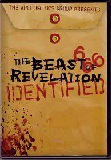

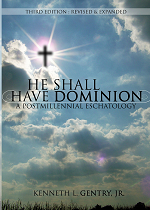
December 1, 2023
CHRIST AND THE REBELLIOUS SON LAW
PMW 2023-094 by Kenneth L. Gentry, Jr.
Christ upholds God’s Law. And this includes his upholding one of the laws most commonly misunderstood and employed today. This law is often used in arguing against the continuing relevance of God’s Law in the civil sphere. He upholds the law calling for capital punishment for incorrigible criminality. Even the parents of a dangerous individual are expected to turn him over to civil authorities for capital punishment:
And He answered and said to them, “And why do you yourselves transgress the commandment of God for the sake of your tradition? For God said, ‘Honor your father and mother,’ and, ‘He who speaks evil of father or mother, let him be put to death.’ But you say, ‘Whoever shall say to his father or mother, “Anything of mine you might have been helped by has been given to God,” he is not to honor his father or his mother.’ And thus you invalidated the word of God for the sake of your tradition.” (Matt 15:3–6)
This piece of capital punishment legislation is frequently brought forward in disgust to demonstrate the absurdity of the Law’s modern application. But this law should never be derided by the Christian for several reasons:
(1) In this very passage our Lord and Savior Jesus Christ defends the application of this law and rebukes the Pharisees for circumventing it. He complains that such people “invalidated the word of God,” calling them “hypocrites” who merely “honor Me with their lips” (Matt 15:7).
 God’s Law Made Easy (by Ken Gentry)
God’s Law Made Easy (by Ken Gentry)
Summary for the case for the continuing relevance of God’s Law. A helpful summary of the argument from Greg L. Bahnsen’s Theonomy in Christian Ethics.
See more study materials at: www.KennethGentry.com
(2) In aligning these two laws from the Mosaic code Jesus specifically declares that they are God’s Law. Note that he states: “For God said. . . .”
(3) This capital sanction is in fact actually found in the Bible, which we are called upon to believe, defend, and promote. To mock a command found in God’s Word as absurd or reprehensible is simply not an option for the Christian. In fact, such a response reminds us of Adam and Eve’s reaction to God’s prohibition in Eden: God commands them not to eat (Gen 2:16–17); but they see that it was “good for food” — so they reject his command (Gen 3:1–6).
Contrary to popular opinion, this capital punishment legislation applies to a son that is: (1) old enough to be a threat to the community through criminal conduct and (2) mean enough to be turned over to the authorities by his own parents. An explanatory expansion of this law describes this son as “a glutton and a drunkard” who cannot be controlled by his parents (Deut 21:18–21). He is a curse to his parents and a menace to his community. This is not a ten year old who refuses to take out the garbage.
THE APOCALYPSE OF JOHN
by Milton S. Terry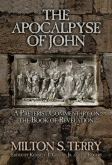
This book is Terry’s preterist commentary on the Book of Revelation. It was originally the last half of his much larger work, Biblical Apocalyptics. It is deeply-exegetical, tightly-argued, and clearly-presented.
For more study materials: https://www.kennethgentry.com/
November 28, 2023
THE TWO WITNESSES OF REVELATION (2)
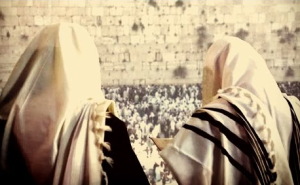 PMW 2023-093 by Kenneth L. Gentry, Jr.
PMW 2023-093 by Kenneth L. Gentry, Jr.
This is the second and concluding article on the identity of the two witnesses in Revelation. In this installment, I present my own view and a portion of my evidence for it.
The first view is that the two witnesses may represent the whole Old Testament order (religious and civil) or content (law and prophecy). The second view is that the two witnesses may represent first century Christianity as a whole.
Third, more probably, the two witnesses may represent a small body of Christians (and maybe even precisely two people) remaining in Jerusalem during the Jewish War (Stuart 2:226-27; cites Wetstein, Daubuz, Lowman, and Zegerus). The three and one-half years are now called 1260 days because it “shows that daily, during this whole time” they prophesy (Düsterdieck 11:314). We know from historical records that Jewish Christians in Judea flee to Pella where they escape the War (Eusebius, Eccl Hist 3:6; Epiphanius, Heresies 29:7; De Mensuris et Ponderibus, 15. Cp. 11:1 with 12:6; cf. Mt 10:23; 24:16; Mk 13:14; Lk 21:21). But perhaps a few remain behind and are designated as “two,” the minimum number for a legal witness in court cases. In fact, the Old Testament prophets function as God’s lawyers representing his covenantal demands upon Israel. They present the Lord’s “case” or “legal charge” (Isa 43:26; 45:21; Jer 2:35; Mic 6:1; 7:9; 4:1; 12:2) against the disobedient, covenant-breaking people (Jer 11:7-8; 31:32). The judicial character of Revelation would support this identity.
Caird inadvertently validates this approach while seeking to rebut it: “If the witnesses were two individual Christians, the city in which they died would have to be a city in the narrow, literal sense; and this hypothesis leads, as we have seen, to a reductio ad absurdum” (Caird 138). Contra Caird, I have shown that strong evidence supports the Jerusalem identity. So then, on Caird’s analysis we may expect that the literality of the city entails the literality of the prophets.

Keys to the Book of Revelation
(DVDs by Ken Gentry)
Provides the necessary keys for opening Revelation to a deeper and clearer understanding.
See more study materials at: www.KennethGentry.com
Unfortunately, we do not have historical documents recording the presence of a Christian witness in Jerusalem at this time. This is due to the lack of any Christian eyewitness account of the Jewish War: Josephus was a Jew, not a Christian. We do know, however, that Christ prophesies about the Christian witness to Israel during the era leading up to Jerusalem’s fall (Mt 24:9-13; Mk 13:9-13; Lk 21:12-16). We also discover that later Christians were quite mindful of the significance of Christ’s prophecy regarding the fall of Jerusalem (For instance, see: Barnabas (ca. 100), 16:1ff. Justin Martyr (147), First Apology 32; 47; 53).
Stuart suggests that these two witnesses are “a competent number of divinely commissioned and faithful Christian witnesses, endowed with miraculous powers” who “bear testimony against the corrupt Jews, during the last days of the Commonwealth, respecting their sins” (Stuart 2:226). This will be the perspective of the following exposition, although neither the first (especially) nor second (less likely) possibilities are wholly discounted. After all, as per the first option, Christianity is the continuation of Israel, the “Israel of God” (Gal 6:16; see exposition of Rev 12; see also: Gal 3:29; Ro 2:28-29; Php 3:3; 1Pe 2:5, 9). And the second possibility is certainly true: the law and the prophets testify of Christ (Mt 11:13; Lk 24:47; Jn 5:39; Ac 17:2-3; 18:28) while the Jewish social order and national experience typifies him (e.g., Mt 2:15/Hos 11:1; Mt 3:17/Is 42:1; Mt 4:7/Dt 8:2; Mt 21:42/Ps 118:22). Thus, Israel now functions in Revelation as the pagan enemy of God, just as were Egypt before Moses and the Baal-worshipers before Elijah. Interestingly, “the most important Jewish settlement in the Diaspora was in Egypt” during the first century.
As Beagley observes:
Even though we cannot be sure what historical situation John may have had in mind when he wrote his account of the mission and fate of the two witnesses, we get some clues from the sigificant parallels between Revelation 8-11 and Jeremiah 4-6 Throughout that section of Jeremiah there are mentions of a trumpet sounding (4:5, 19, 21; 6:1, 17; cf. the seven trumpets in the Book of Revelation); the heavens are to become black (Jer 4:28 cf. Rev 8:12; 9:2); the prophet’s words are to become a fire which will destroy the people of Judah because of their harlotry and their complacent confidence that Yahweh will take no action against them. Because of all this the nation is to be conquered and taken captive (Jer 5:7-17, especially v 14; cf. Rev 11:5). Jer 6:1-8 warns specifically of the siege and destruction of Jerusalem. All this suggests that John’s description of the ministry of the witnesses may well be intended to signify that their message was one of judgment on Jerusalem and the nation of Israel.” (Beagley, 66)”
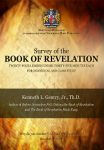
Survey of the Book of Revelation
(DVDs by Ken Gentry)
Twenty-four careful, down-to-earth lectures provide a basic introduction to and survey of the entire Book of Revelation. Professionally produced lectures of 30-35 minutes length.
See more study materials at: www.KennethGentry.com
Therefore, in this interlude (Rev 10:1-11:14) before the final trumpet (Rev 11:15), God promises to secure the witness of Christ to the world (regarding salvation for all nations) and to the Jews (regarding judgment for covenantal defection). The “strong angel” (Christ) of chapter 10 declares the inclusion of Gentiles by uniting of Jew and Gentile into one body. He immediately reminds John of his commission to prophesy to the “nations” (10:11), as per the Great Commission (Mt 28:18-20; Lk 24:47-48)Then he has John measure out a new people from within old Israel, the seed of the ongoing Church (Rev 11:1-2). And finally he commissions “my two witnesses” to testify of the divine nature of Israel’s judgment as God turns to the nations (cp. Mt 8:10-12; 21:43). The inner temple (11:1) — aka “the 144,000” (Rev 7:4-8) — is the beginning of the new phase of the kingdom, it is the very seed of the universal Church (Ro 11:16), the foundation of the rebuilt temple of God (Eph 2:19-20; 1Co 6:15; 1Pe 2:5).
November 24, 2023
THE TWO WITNESSES OF REVELATION (1)
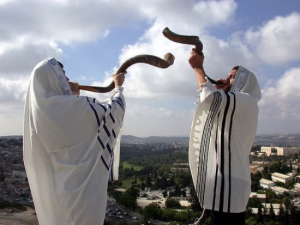 PMW 2023-092 by Kenneth L. Gentry, Jr.
PMW 2023-092 by Kenneth L. Gentry, Jr.
The two witnesses in Rev. 11 have generated much discussion among Revelation enthusiasts. Though they only appear here in John’s forensic drama, they play an important role regarding the temple’s destruction. But debate continues over their identity. In this and my next blog posting, I will present the three leading options on their identity.
Old Testament order
First, the two witnesses may represent the whole Old Testament order (religious and civil) or content (law and prophecy) (Bahnsen; Clark; Chilton). Israel has sinned against the covenant of her God; the whole Old Testament witness stands in judgment against Israel — as per the sermons by Peter (Acts 2:16-36) and Stephen (Acts 7:2-53). Interestingly, Moses and Elijah appear with Christ at the Transfiguration to transfer their authority over to him, who must now be heard (Mt 17:3-5; cp. Heb 1:1-2). The divinely established old covenant order arises anew as a transformed new covenant reality (as per Jer 31:31-34). The whole argument of Hebrews is the transcendent superiority and everlasting permanence of the new covenant in Christ as it supercedes the temporary old covenant embodied in Moses (e.g., Heb 3:1-6; 8:5-13; 9:18-10:10; 10:26-31; 12:21-29).
In the first century Israel grievously sins in rejecting the Messiah in defiance to the prophecies, types, and symbols of the Old Testament (Jn 1:45; 5:39-40; Lk 24:25-27, 44; Ac 24:14; 26:22; 28:23-28). She should have believed the law and the prophets, just as the rich man should have: “Abraham said to him, ‘They have Moses and the prophets; let them hear them…. If they do not hear Moses and the prophets, neither will they be persuaded though one rise from the dead'” (Lk 16:29, 31). As Philip reports to Nathaniel after meeting Jesus for the first time: “We have found Him of whom Moses in the law, and also the prophets, wrote — Jesus of Nazareth, the son of Joseph” (Jn 1:45).
The Beast of Revelation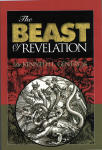
by Ken Gentry
A popularly written antidote to dispensational sensationalism and newspaper exegesis. Convincing biblical and historical evidence showing that the Beast was the Roman Emperor Nero Caesar, the first civil persecutor of the Church. The second half of the book shows Revelation’s date of writing, proving its composition as prior to the Fall of Jerusalem in A.D. 70. A thought-provoking treatment of a fascinating and confusing topic.
For more study materials, go to: KennethGentry.com
Paul in his defense against the charges of the Jews argues: “Therefore, having obtained help from God, to this day I stand, witnessing both to small and great, saying no other things than those which the prophets and Moses said would come” (Ac 26:22). Indeed, Paul’s witness to the Jews was from Moses and the prophets: “So when they had appointed him a day, many came to him at his lodging, to whom he explained and solemnly testified of the kingdom of God, persuading them concerning Jesus from both the Law of Moses and the Prophets, from morning till evening” (Ac 28:23). According to Neusner Elijah became for Israel a “model of [the] ideal prophet” as well as “the master interpreter of Torah and the revealer of its hidden meanings” (Jacob Neusner, ed., Dictionary of Judaism in the Biblical Period (Peabody, Mass.: Hendrickson, 1996), 189. See: Mk 1:4-6; Lk 3:7-9; Wars 6:5:3; Origen, Celsus 7:9.)
Tragically, the Jews did not recognize the time of their visitation: “For days will come upon you when your enemies will build an embankment around you, surround you and close you in on every side, and level you, and your children within you, to the ground; and they will not leave in you one stone upon another, because you did not know the time of your visitation” (Lk 19:43-44). Thus, Rome’s destroying Israel’s religious and civil system clears the way for the heavenly system of Christianity. This interpretation is not only reasonable and important, but relevant. And it probably at least suggests the broad theological backdrop for the next two related possibilities.
First Century Christianity
Second, the two witnesses may represent first century Christianity as a whole. They may suggest either the “apostles and prophets” as the foundation stones of the church, the new temple of God (Eph 2:19-20; 1Pe 2:5-9) (Terry, 369). Or they may picture Christianity as a nation of “priests and kings,” like Joshua-Zerubbabel (Caird, 134). The new faith is certainly commissioned to take her witness out into the world (Lk 24:48; Ac 1:8; 2:32; 3:15; 5:32; 10:3, 41; 13:31) — and meets with opposition from the Jews (Rev 2:9; 3:9; Acts passim).
Before Jerusalem Fell
(by Ken Gentry)
Doctoral dissertation defending a pre-AD 70 date for Revelation’s writing. Thoroughly covers internal evidence from Revelation, external evidence from history, and objections to the early date by scholars.
See more study materials at: www.KennethGentry.com
The transition from three and one-half years in 11:2 to 1260 days in 11:3 would be due to these time-frames representing different periods, with the awkward measure (counting off 1260 days is more troublesome than counting out 42 months) being a symbolic figure aligned theologically rather than historically with the more literal one. As “great persecution” breaks out against the Christians (Ac 8:1), Saul begins delivering them to Jerusalem authorities to be put to death (Ac 9:1-2). It would appear Christianity would be stamped out. In fact, as Christ warns “unless those days had been cut short, no life would have been saved; but for the sake of the elect those days shall be cut short” (Mt 24:22). The “week” has been cut short; the perfect number broken in half.
Nevertheless, Christianity serves as a witness to God, arises with new vigor after the destruction of Jerusalem, and is blessed from heaven above. Later we will see the martyrs reigning from heaven (20:4-6). As Poythress notes of such imagery: “Within a visionary framework, such a picture powerfully depicts the idea of a vindication coming through new life” (Vern S. Poythress, “Genre and Hermeneutics in Rev 20:1-6,” Journal of the Evangelical Theological Society 36 (March 1993): 48).
To be continued.
November 21, 2023
MESSIAH AND ISRAEL’S “RETURN”
PMW 2023-091 by Kenneth L. Gentry, Jr.
Isa. 43:5–7 is a glorious prophecy. It reads:
“Fear not: for I am with thee: I will bring thy seed from the east, and gather thee from the west; I will say to the north, Give up; and to the south, Keep not back: bring my sons from far, and my daughters from the ends of the earth; Even every one that is called by my name: for I have created him for my glory, I have formed him; yea, I have made him.”
Despite initial appearances, these verses do not refer solely to Israel’s return from the Babylonian dispersion. Rather they refer beyond historic Israel to spiritual Israel gathered out from the nations through the worldwide spread of the gospel (Psa. 22:27–28; Isa. 2:2–4; Matt. 28:18–20; John 12:32; 1 Cor. 15:24–26). Isaiah is looking beyond the Babylonian exile to ultimate eschatological issues. Israel’s return from exile was an historical event that served as a typological pointer to worldwide redemption.
Four issues undermine any singular focus on the Babylonian return here:
(1) He does not say he will bring Israel “back” to the land (cf. Zech. 8:8; 10:6, 9, 10; Jer. 23:3; 8:37; 32:37).
(2) The four cardinal directions point beyond Babylon, which was northeast of Israel. This ultimately promises that Christ’s church will be brought together from all over the world (vv. 6b–8; cp. Matt. 8:11–12; John 11:52; Rom. 3:29; 1 John 2:2).
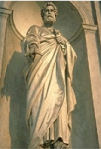
Van Til Conference on Eschatology (3 mp3 lectures)
Three formal lectures on various aspects of postmillennialsm.
An excellent introduction to postmillennialism from a distinctly Reformed perspective. Includes discussion of the leading objections to the postmillennial hope
as well as an application of Van Til’s apologetic method to the postmillennial argument.
See more study materials at: www.KennethGentry.com
(3) “The Servant,” who is so prominent in the larger surrounding section of Isaiah, is the Messiah. He comes to draw all men to himself (Matt. 28:18–20; John 10:16; 12:32; Eph. 2:13–18); but he is rejected by Israel (Matt. 23:37; John 1:11; 7:45–52; 8:39–59, 10:22–4219:14–15; Acts 4:10–11; 13:45–47; 18:6; 19:9; 22:21; 26:20).
(4) God speaks of Israel’s “offspring” (Heb., zara, “seed,” v. 5), which involves the church, which is “Abraham’s seed” (Gal. 3:7, 29; cp. Rom. 4:13, 18), the “Israel of God” (Gal. 6:16).
We need to read this passage in its literary context. It is found as a key statement in Isaiah 42:1–53:12. This major twelve-chapter section of Isaiah points out the gracious means by which God’s will is to be accomplished in the earth. Herein we find the four “Servant Songs” (see 42:1–9; 49:1–6; 50:4–9; 52:13–53:12). The “servant” concept speaks of one closely related to God and who is faithfully engaged in his service. For instance, we see this in “servant” references regarding Moses (Exo. 14:31; Num. 12:7; Deut. 34:5; Josh. 1:1–2; 9:24; Neh. 1:7; Dan. 9:11), David (2 Sam. 7:5, 26; 1 Kgs. 3:6; 8:25; Isa. 37:35; Jer. 23:21–22; Eze. 34:23–24; 37:24), and Isaiah (Isa. 20:3).
 The Truth about Salvation By Ken Gentry
The Truth about Salvation By Ken Gentry
A study guide for personal or small group Bible study. Deals with the Christian doctrine of salvation from a Reformed theological perspective. It opens with a study of God as loving Creator, the shows how the first man fell into sin. Shows God’s righteousness requires that sin be dealt with. Presents Jesus as both God and man so that he can be man’s Savior. Includes review questions and questions for further study.Twelve chapters are ideal for one quarter of Sunday School.
See more study materials at: www.KennethGentry.com
In Isaiah’s songs the Servant is both a corporate figure and an individual person, though the “Servant’s” first appearance in Isaiah is corporate (41:8). That is, it speaks of the nation of Israel ideally conceived (49:3; cp. 41:8; 43:10; 44:1, 2, 21; 45:4; 48:20) and the Messiah-Redeemer personally considered (42:1; 49:5–7; 53:1–5, 11). In the corporate sense “My servant” is flawed, being spiritually blind and deaf (42:19). In the personal sense, this prophecy is fulfilled in Jesus (Matt. 12:18–21; 1 Pet. 2:21–25). Isaiah always speaks of him in the present tense (42:1) or as already operating (49:1; 50:4; 53:2) because of Christ’s pre-existence (Mic. 5:2; John 1:1; 8:58; 17:5; 1 Cor 8:6; Col. 1:17; Heb. 1:10).
Kenneth L. Gentry Jr.'s Blog
- Kenneth L. Gentry Jr.'s profile
- 85 followers



